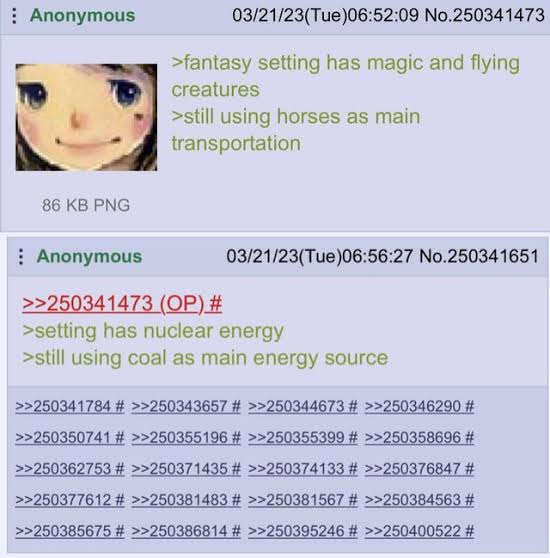- cross-posted to:
- science_memes@mander.xyz
- cross-posted to:
- science_memes@mander.xyz
I’ve always found it slightly funny that nuclear power is technically just a fancy steam engine.
Almost all power source that generate electricity are fancy steam engines.
Wait, it’s all steam engines?
🔫 👩🚀🔫👩🚀 always has been
Never got this meme honestly, I should figure it out sometime 🔫🧑🚀🔫🧑🚀
What?!? It was always just a meme?!?
I thought it was a reference I didn’t get because I’m an old.
Always has been 👩🚀🔫👩🚀.
But actually that article is pretty thin. I believe it was originally a joke about how many astronauts are from Ohio, so they’d get to space and it would turn out the whole planet was Ohio. It is in fact a reference to real world thing, it’s just a very obscure and absurd reference.
Hydro, wind, solar, and wave/tide energy capture are not.
The crazy part is photovoltaics are the only power source that doesn’t spin something to make electricity. Truly an outlier.
solar
Except the ones that are. (Concentrated solar power)
…and the fancy steam engine version of solar is probably greener to build that photovoltaics, since it’s basically just a boiler and some mirrors.
Internal combustion engine based generators aren’t fancy steam engines either - however, they have a lot in common still. It’s still just a way to move around the spinny bits of an alternator/generator/dynamo/whatever
Not entirely true, there is the thermoelectric generator too. Though it’s not very practical
There’s one more outlier though which is Electrochemical cell, like galvanic element or voltaic pile
It was used around 1800 as a major electricity source, but I guess it quickly became uneconomical in 1866 or sth when the dynamo was invented.
Edit: wait yes, it actually says this in the second paragraph of the linked article:
The entire 19th-century electrical industry was powered by batteries related to Volta’s (e.g. the Daniell cell and Grove cell) until the advent of the dynamo (the electrical generator) in the 1870s.
Great call! Completely forgot about batteries and potato power sources!
Which requires them to output DC rather than AC, so they require inverters to change it to AC. It’s handier for battery storage though.
deleted by creator
Hydro is the most fancy steam engine since it waits for the water to recondense to make power.
Condensed steam.
Wait so does that make wind power more or less fancy than hydro?
Air is a fluid, it’s hydrodynamics all the way down.
Everything is a fluid. Sand is a fluid. Sand and water? Only sometimes.
Edit: this was not on topic, I just got mad at my old physics teacher for a second and channeled 16 year old me, sorry
It’s cool. I get why it’s easy to see the universe as various fluids. We are

Depends on the humidity
Photovoltaics have left the chat.
Well, wins turbines too
Piezoelectrics have left the chat
I never understood that either. It seems like the steam production is an extra step.
So my general understanding is that you can use a magnet to create an electrical current. Its like it pushes the electrons, like a paddle pushing water. So they coil a bunch of wire around a magnet and rotate the magnet, which moves the electrons in the wire and that gets you electrical power. But you need something to push that magnet around, so you attach that to a big ass fan and use steam to push the fan. That’s your turbine. Nuclear power is just using a hot rock to make the steam. Hydroelectric power uses a river to push the turbine. Wind power is doing the same thing, just uhhh, with wind.
Honestly, fantastic explanation!
Jesus christ this comment deserves a noble prize. Incredibly succinct explanation of something I didn’t get before.
It’s pretty much the only pathway to make heat spin a turbine.
Well, efficiently, at least.
You can always heat up a hot air balloon and have it yank a system of pulleys, but you’re gonna lose a lot of energy that way.
Turning heat into mechanical or chemical or electric energy directly is really hard, you know.
It’s funny that you can get more energy from gas by using it to heat water and using a steam turbine to drive whatever. It’s just not always practical.
I’m not really sure how else you’d do it. The energy we can get out of fission is in the form of heat, and steam isn’t as compressible as just gas and it’s easy to make with just heat. Combine that with electromagnetism giving you electricity by spinning some magnets around some coils, and there you go.
It’s probably possible to get some air hot enough and do some fancy convection work to get it to spin a rotor, but that’s going to be really inefficient.
You could also use the heat to make materials glow and put a solar panel nearby, but that’s also going to be pretty inefficient.
Get beta radiation and then put the electrons directly into the wires.
One by one.
Artisanal, hand wrought electricity.
It’s just taking advantage of the change in matter state. H2O expands ~16,000 times it’s size when it boils from liquid water to gaseous steam. That increase in size means it wants to go somewhere else, we just control where it goes and it’s relief valve happens to be going through a spinning wheel with magnets on it, inducing currents in the coils of wire around the wheel.
Yes it’s way more complicated than that, but it’s the best way we have of turning heat into electricity, so it’s what we use. With the primary exception of solar, nearly every form of power production is using heat energy to indirectly spin a wheel.
I swear Nuclear Reactors were designed by a chemist with a grudge against a physicist and engineer.

Totally totally no downsides.

tbf, we have airplanes, but most goods are still being transported over lands or seas.
It was a bad call to stop, but now it’s an equally or worse call to start again.
Renewables win on essentially every measure and get better every day while nuclear gets worse every day.
how is it getting worse? there are tons of modern fail-safes
It’s getting more expensive year over year, while renewables are plummeting in price.
Nuclear gets more expensive. That’s worse.
That’s a lie. Renewables produce more CO2 than Nuclear reactors per unit energy produces. They can also be significantly more dangerous (higher number of deaths per unit energy) in the case of hydro power or biomass. Solar and batteries require various rare materials and produce significant pollution when manufactured and must be replaced every 20 or 30 years.
That’s a lie.
Not really, no.
Renewables produce more CO2 than Nuclear reactors per unit energy produces.
From what I gather, wind is on par with nuclear. Other renewables have slightly more than either wind or nuclear, but compared to the other nonrenewable alternatives either option is far better.
They can also be significantly more dangerous (higher number of deaths per unit energy) in the case of hydro power or biomass.
You left out that solar and wind are largely on par or safer than nuclear per unit of energy. All of these options are again far safer than other nonrenewables.
Solar and batteries require various rare materials and produce significant pollution when manufactured and must be replaced every 20 or 30 years.
As opposed to the ever so clean extraction and storage of nuclear fuel? Come on.
And all of this leaves out the most important aspect - nuclear is incredibly expensive compared to renewables, and is trending more expensive each year, while renewables are trending in the opposite direction. This means that for the same amount of resources, we will be able to displace more nonrenewables, leading to a net reduction in deaths/emissions pursuing this route as opposed to nuclear.
Of course, I have nothing against fully privately funded nuclear. If private actors can make the economics work under safe conditions, then nuclear construction is an obvious net positive. When they displace public investment in renewables, however, then they are a net negative.
Not really, no.
Have you actually looked at the data? You might be surprised.
As opposed to the ever so clean extraction and storage of nuclear fuel? Come on.
Yes actually. Uranium mining isn’t nearly as bad as needing tons of lithium, cobalt, and who knows what that goes into solar panels. Thorium containing materials are literally a byproduct of other mining operations that gets thrown away.
From what I gather, wind is on par with nuclear. Other renewables have slightly more than either wind or nuclear, but compared to the other nonrenewable alternatives either option is far better.
Nope. Wind generates 11 tons of CO2 where Nuclear only makes 6. Solar isn’t even close. Biomass is the worst of the renewables and is closer to fossil fuels in its pollution levels than the other clean sources of energy.
https://ourworldindata.org/safest-sources-of-energy
And all of this leaves out the most important aspect - nuclear is incredibly expensive compared to renewables, and is trending more expensive each year, while renewables are trending in the opposite direction. This means that for the same amount of resources, we will be able to displace more nonrenewables, leading to a net reduction in deaths/emissions pursuing this route as opposed to nuclear.
Is it? Most people aren’t factoring the cost of energy storage. No one is suggesting Nuclear as the only source of energy. It is very helpful though for grid firming and reducing the amount of expensive and environmentally destructive energy storage therefore reducing the overall cost of operating the grid while increasing reliability and reducing land usage and environmental damage.
While the upfront investment in reactors is large, the cost per energy produced and ongoing costs are quite low. Lower in many cases than fossil fuels like gas. Plus reactors last longer than solar panels and wind turbines.
Of course, I have nothing against fully privately funded nuclear. If private actors can make the economics work under safe conditions, then nuclear construction is an obvious net positive. When they displace public investment in renewables, however, then they are a net negative.
What happened to the idea that renewables didn’t need public funding anymore? If it’s really so cheap as you say that wouldn’t be necessary.
The reality is both renewables and nuclear needed huge state investments to get off the ground.
It’s also cheaper than solar in many cases. While the upfront investment in reactors is large, the cost per energy produced and ongoing costs are quite low. Lower in many cases than fossil fuels like gas. Plus reactors last longer than solar panels and wind turbines.
Solar + storage is currently at less than half the cost of nuclear, while wind + storage is at a third of the cost: https://www.statista.com/statistics/1475611/global-levelized-cost-of-energy-components-by-technology/
I’m going to work on the assumption that you’re working off old data, because the claims you made are very far from where we’re actually at.
What happened to the idea that renewables didn’t need public funding anymore? If it’s really so cheap as you say that wouldn’t be necessary.
In many cases, public funding is no longer necessary for renewables. That’s why Texas of all places is becoming a wind powerhouse. Energy storage technologies are less mature and still warrant public investment.
Both renewables and storage technologies have something very important in common - they are absolutely plummeting in costs year-over-year, meaning that while nuclear is not competitive on price today, it’s just going to get worse from here on out.
I like to look at Sweden as an example, where the current government is pushing investment in nuclear. Their proposed plan is to:
- Have the public guarantee loans for nuclear construction
- Have the public guarantee a minimum kWh-price for these facilities
Aside from being incredibly expensive for the public, displacing other potential investment whether they be in energy production, other climate initiatives or just investment into the welfare of the population, it also makes private investment into renewables less lucrative and as such less likely to happen. On top of that, it’s being used as an excuse to not grant permits for construction of renewables by aforementioned government.
Can you link a source that isn’t pay walled?
No one is suggesting Nuclear as the only source of energy. It is very helpful though for grid firming and reducing the amount of expensive and environmentally destructive energy storage therefore reducing the overall cost of operating the grid while increasing reliability and reducing land usage and environmental damage.
Nuclear reactors are not useful for grid firming in a renewable grid, because they have to be running at 100℅ all the time to be anywhere near economical.
Renewables (wind-/solar) aren’t the most predictable sources of energy, so they need something to jump in when power demand is higher than supply. Nuclear reactors can’t deliver on that use case, while battery-storage, pump storage, biomass etc. can.
This means a grid with 30℅ nuclear would have to stop wind turbines and solar panels (free energy, since they are already built) instead of powering down more costly biomass. This results in more expensive renewables (as they aren’t used to their full capacity).
Believe it or not you can turn a reactor off if necessary, or up and down. Crazy I know.
Biomass isn’t practical as it releases far too much emissions to be worth it, you almost might as well use gas. Actually thinking about how much land use it would take, it might actually be worse than gas overall. Biomass is only really sensible when talking about material we would waste anyway like food waste and other waste that can be burned, but that would barely make a dent in our energy needs.
Not everything is about economics, otherwise we probably wouldn’t be talking about renewables at all.
As for “free energy”, no energy is free. Solar panels and wind turbines still have a finite life span. Nuclear fuel is cheap enough to the point where it too might as well be free if we are willing to call wind turbines free. This is especially true for Thorium technology or actinide burners. Actinide burners literally reuse nuclear waste.
Not everything is about economics, otherwise we probably wouldn’t be talking about renewables at all.
Taking the long term impact of coal, gas and oil on our climate and nature into account, renewables are cheaper. The cost of destroyed infrastructure through (ever more likely) extreme weather events alone is immense and often not taken into account, not to mention the impact on food.
The amount of money countries have is limited. If the goal is to replace coal, gas and oil as quickly as possible it’s more efficient to use cheaper technology.
As for “free energy”, no energy is free.
Yes, my point was about already built solar and wind turbines, that lose money the moment they are not running. The same is true for a powered down nuclear reactor, as the fuel isn’t the expensive part of the operation.
My point is that technology that is expensive even if not curently in use, does not make for good backup power. This makes renewables and nuclear not a good combination, as it’s quite expensive.Biomass isn’t practical as it releases far too much emissions to be worth it, you almost might as well use gas.
Yes, biogass is only an option as an addition and shouldn’t be used continuously (for backup power it should be fine).
This is especially true for Thorium technology or actinide burners. Actinide burners literally reuse nuclear waste.
Those are future technologies never used commercially (if at all). Thorium reactors are not even in the testing stage yet, it’s even worse if you look at acinide burners. I’d like to switch to low emission energy now, not in a few decades.
So, I don’t know why you’re taking a stand for Uranium today. It used to be a good technology 30 years ago, but today it just doesn’t make any sense anymore.
First factor is cost. Renewables (Solar + Wind especially) have really really gone down in cost (see this link and this link), and the population will favor the energy source that is cheaper in the long run.
Secondly, the environmental impact of solar is really not that big. When we talk about how much CO2 solar produces, it’s mostly because that solar needs silicon and that needs energy to be purified. And that energy mostly comes from coal, gas or other non-renewables today. But guess what, as the solar revolution progresses, that emission goes down as well, so solar actually becomes more environmentally friendly over time.
This article makes me think I gotta buy some nuclear stocks, but I am hesitant because lemmy might be late on hype cycle. What do you think
Nuclear stocks rise and fall with state funding. It’s neither practical to privately ensure a fission recator, nor is it practical to build them privately.
There are better investments.
Feel free to put money into it if you believe in it. Given nuclear’s track record with regards to actually making money is not particularly strong though, so I wouldn’t advise doing this if you actually want to make a return on your investment.
Another important point is the flexibility of wind and solar. The minimum investment to get some power out of them is very low, and a park can start generating power before fully completed and can easily be scaled up or down in capacity during construction if estimates change.
Nuclear on the other hand is a huge up-front cost with little flexibility and no returns until completion, which could take a decade or more.
Even if it wasn’t more expensive, nuclear would still be financially risky. Many things can happen that effect power consumption and prices during the time it takes to build a nuclear plant. It can still be valuable for diversification though.
Conveniently leaves the “get the fissile material” and “store the used fissile material” steps out.
Also: build the thing
Also: unbuild the thing
Well that solves itself sometimes but…
Run low on water, stop reaction. Fission products keep getting hot even though reaction stopped. Not enough water to cool them off. Shit.

This scene was really outstanding
What’s that from?
The Chernobyl miniseries on HBO. It’s a great watch!
Ah, thanks. I’ll check it out.
thankfully modern ones like molten salt reactors have passive safety, where they stop the reaction if overheating occurs.
edit: My mistake, there’s no active commercial molten salt reactors.
But nuclear power is very safe nowadays because of the multiple fail-safes, which some can still be passive like emergency cooling.
I much rather get electricity from magic rocks than destroying rain forest in developing countries drilling oil, gas or mining coal.
The biggest risk in nuclear is environmental disasters like in Fukushima’s case, which is the last significant nuclear incident in past 13 yearsAnd are those modern molten salt reactors in the room with us now?
2 MW. Fantastic. And only 8 years until it reaches continuous operation. How long will it be before that is anywhere near utility scale?
Ah yes, the passive safety of the molten salt spontaneously catching on fire when in contact with air and can’t be put out with water.
deleted by creator
You can’t stop decay heat. It’s just molton salt reactors can operate at much higher temperatures and if it loses active cooling passive cooling with just air and infrared radiation while the salt passively circulates could be enough.
there’s no active commercial molten salt reactors.
Experimental ones were all shut down within 5-10 years because corrosion makes them uneconomical to repair.
Fukushima’s case, which is the last significant nuclear incident in past 13 years
Zaporizhzhia (shutdown with IAEA concerns but may not fully report any emission releases) in Ukraine has military attacks against it, with intent of fundraising and politically blaming a disaster on the side that weapons providers, and the media they own, love to hate. Our media normalizes civil war as a response to Netanyahu not having his favorite ruler appointed.
Isn’t molten salt just energy storage? Heat up salt when you have excess of energy, take heat out when you need it. The worst disaster there is just the container melting.
No, there are molten salt thermal batteries, but they aren’t the same as molten salt nuclear reactor. In a nuclear reactor the fissile material is dissolved in the salt for some reason, and the molten salt acts as a moderator or something. Apparently its safe because if the reactor power fails, the salt ‘freezes’ which prevents fission from occurring. Seems like complex extra steps to me but what do I know.
“Can’t have a meltdown when you’ve already melted the fuel” is pretty much the whole idea there.
MSRs have negative temperature reactivity coefficient and outlet temps around 700C at atm pressure. PWR is at measly 300C and 150 Bar.
If all control is lost, the salt expands as it heats up pushing the expanded volume out from the reactor core. The fission stops once the fuel is leaves the core region where the moderator is. Reverse is also true: you pull heat off from the loop, so the fuel-salt becomes denser, increasing reactivity. MSRs can naturally “follow” the load, if done right.
Thorium Thorium Thorium Thorium Thorium
Uranium it is, then!
Turn water back on suddenly and realize what happens when water touches an object many times warmer than it’s boiling point.
Just throw some sand and boron on it, she’ll be right mate.
Same applies to geothermal.
lava is really hot
use lava to boil water
use steam to turn a generator
free electricity!
Have we still not been able to progress past all power generation being “use water to turn a generator”? Humanity figured out the water wheel then just kept making it more complex.
How about “use air to turn a generator”? Now that’s original. Or photovoltaics, I guess.
So I’ve tried starting a perpetual windmill and it made money on only fans but it turned out the be an electrical loss overall… Had to abandon that attempt, back to the drawling board, I think I messed up somewhere.
You know that windmills are kind of the opposite of fans? Try “only windmills” instead and it’s not a
:.|:;anymoreSo I reversed the windmill to a helicopter, more views, still an overall electrical loss. Thanks for trying though. I might not be the best person for this job.
Guess I should start scouting for talent
We have! Thermoelectric generators that make electricity directly from heat exist, they’re just often not very good compared to the spinny wheel.
We even use them to make nuclear reactors with no moving parts, which I think is really neat. They’re used in places where maintenance or refueling is difficult or impossible, like space probes.
https://en.wikipedia.org/wiki/Radioisotope_thermoelectric_generator
What about a piss wheel instead of a water wheel?
Chat is this legit gameplay or an exploit?
Trolls and exploiters at it again. If god intended for us to make nuclear energy then he would’ve made it appear in nature. Stupid scientists making stuff from gods creation.
Well do I have news for you
https://en.m.wikipedia.org/wiki/Natural_nuclear_fission_reactor
Well but they’re not around anymore because the uranium inside them is all consumed by now, right?
Uranium is still there, it’s just sub-critical mass so the reaction isn’t happening. Uranium 235 (which would have powered the reaction) has a half life of ~700 million years. So there’s still probably a good bit of it there - the reaction is thought to have stopped about 1.7 billion years ago.
that makes sense, yeah
The Sun
that’s fusion, not fission
He said nuclear not specifically fission
ok
Exactly
Is just trolling.
I love these, there’s no way that would ever work
free
The only completed attempt in last 25 years in US (Vogtle), cost over $15/watt. Before fuel, operations, security, waste disposal plan, and no insurance.
Turnkey (containers full of batteries) systems in China are under $100/kwh. A possible imported cost of $100/kwh.
5gw of solar and 19gwh batteries would have higher capacity factor than nuclear, use same transmission infrastructure size, and cost $7/watt. Where winter production is not enough to fill batteries, the batteries can still be charged by wind or peaker plants that can run a bit more efficiently for a continuous time over a day instead of in bursts.
TBF 90% of the cost of nuclear in the US is political resistance. Not engry meeting
100% of nuclear funding is political bribery. It is unbankable and uninsurable. Through bribery, cost+ funding can be obtained. More bribes = more covering of cost and time overruns.
If what you mean by “political resistance” is that bigger bribes are needed to overcome unpopularity, that is a tiny fraction of the bribery amount. Elected officials do blatantly destructive and unpopular acts all the time. The rate of approvals has little to do with project costs once approved.
Got any proof of big nuclear meddling
Ohio corruption scandal was over nuclear industry bribes. All nuclear projects are publicly funded, and because they are categorically uneconomical, and delay any impact on global warming for 15 years, they are lobbied for by fossil fuel competitors. Boondoggles based on disinformation necessarily require political body to be corrupt and in on it, rather than just stupid.
That’s pretty bad and undeniable. Does this account for all nuclear funding though?
Having no economic value does mean only corruption pretends nuclear energy to have economic value. Another dishonest, but bribed by defense instead of utility operator, motive is weapons.
There is an honest exception of a small town in Arizona (lack of water). They admit their power project costs are astronomical for nuclear compared to solar alternative, but the permanent jobs provided by a nuclear plant raise property values and taxes a bit. This too, no matter how honest the motives, is corruption in obtaining other people’s money to finance a project for local jobs and property values.
deleted by creator
Disclaimer: I am a nitpicker, so apologies for this.
I do believe the symbol of the watt should be capitalized: W. Also the SI prefix giga, G. So that would be kWh, GWh, etc.
deleted by creator
Damn, if you call this constant, I’m scared to guess what do you mean by fluctuating https://www.researchgate.net/figure/Hourly-production-and-hourly-average-wind-speed-mast-and-MERRA-for-an-exemplary-month_fig1_276421124
EZ It’s not rocket science
Love my big pot of spicy water.
don’t drink the spicy soup!
Coming up, troll physics explains rocket science.
Would read
Got you fam
Step 1 put liquid in mouth
Step 2 spit liquid fast
Go to step 1
i’m willing to have fizzle reactors on the moon. and mars. but i am not willing to shoot the fizzle materials via rockets to the moon or mars because of rockets tendency to blow up when designed and built by the humans.
i want no earth fizzle.
Chernobyl could have been so much worse.
Considering the unregulated capitalist hell scale we live in, I can’t trust that some mega corp wouldn’t cut corners.
Until you run out of that fissile material when you could just be using renewable energy…
deleted by creator
I would hazard a guess that it ain’t work like that.
You need a moderator to facilitate a slow fisson reaction. Some of the produced neutrons have misfit speed to create another fisson reaction.
Also note that fissile and radioactive is not the same, but you used them correctly.
no it works exactly like that, I have 200 nuclear reactors in my backyard
Why use 200 small reactors in the ground when you can use one really big one in the sky?
David Hahn? What are you doing on Lemmy? I thought you died!
I see all these pictures where the steam seemingly just escapes into the atmosphere.
Are there any designs where the cooling steam condenses and then pools and falls back down as liquid to turn even more turbines via gravity like hydroelectrics dams and then returns to the source pool to be reheated by the nuclear materials?
That’s not how modern power plants work. It’s not an open loop to the cooling tower, instead you have a closed loop that gets superheated under high pressure and runs the turbines, but needs to get cooled down before the loop can start over. You cool it down by running the pipes through other water, which evaporated in a cooling tower. The evaporated water takes the heat out of the system, if you returned it to the loop, the system would overheat
Ooooo That’s a neat concept
Atom floats on atom























